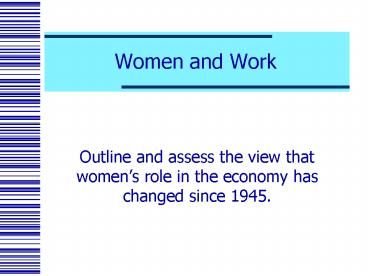Women and Work - PowerPoint PPT Presentation
Title:
Women and Work
Description:
Women and Work Outline and assess the view that women s role in the economy has changed since 1945. Changes to the economy There was labour shortage after 1945 but ... – PowerPoint PPT presentation
Number of Views:64
Avg rating:3.0/5.0
Title: Women and Work
1
Women and Work
- Outline and assess the view that womens role in
the economy has changed since 1945.
2
Changes to the economy
- There was labour shortage after 1945 but there
was increasing unemployment after the 1970s. - Heavy industry (coal mining, iron and steel) has
declined. - Service sector (call centres, catering) has
increased.
3
Gender and change
- Male employment opportunity has declined.
- Female employment opportunity has increased.
- There is more part-time low paid work.
- Women are generally employed in such work.
4
Gender segregation
- Men and women do different types of work.
- Women are over-represented in least skilled and
lowest paid jobs. - White men appear in the management structures.
Women tend to be in junior and low paid clerical
secretarial work.
5
Managers
6
Class and gender
- Middle class women are tending to take on male
professional occupations, but generally the lower
paid, lower status work (teaching, public
services) - Females are not taking on male occupations in
working class work. Traditional working class
work is therefore male.
7
Female work
8
Ethnicity and gender
- Ethnic minority people are focussed in some
industries Chinese/Bangladeshi people in
catering for instance, Afro-Caribbeans in the
health service. - There are different gender patterns of work among
some communities with Afro-Caribbean women taking
on professional work and Bangladeshi women being
less likely to work.
9
Pay
- The Equal Opportunities Commission monitor pay
rates over the years. - Women earn less than men.
- The average pay differential is 20
- Part-time female workers earn 60 of what men
earn.
10
Self-employment
- Self employment is higher among men than women.
- Womens work tends to support male
self-employment (secretary, shop assistant). - Women are more likely to be employed in the black
economy and as home workers.
11
Gender ideology and work
- Male work is heavy, dangerous, outdoors,
aggressive, technical and highly valued. - Female work is boring, repetitive, low status,
and involves subservience to male authority. - Female work is based on gender assumptions of
dexterity, caring and emotional support of
people. - Scott (1992) female work is drudgery.
12
Female work as drudgery
13
Gender and work
- Early studies looked at how married women
combined paid work with domestic chores. - Government policies saw women as domestic
labourers who also had jobs domestic roles were
paramount. - Working mothers were blamed for delinquency among
children.
14
Recent studies
- Recent studies look at how women are treated in
work, how gender divisions remain despite
equality legislation. - Males control technology and skills, excluding
certain people from training and jobs. - As skilled jobs became mechanised and accessible
to women, this challenged gender assumptions and
males felt threatened.
15
Sexuality and work
16
Workplace culture
- Workplace culture is masculine.
- Examples include girly posters, male centred
conversation, and sexual harassment. - However, males crossing into female work
experience similar discrimination. - Females in work downplay their femininity and
regulate their bodies in such a way as to render
themselves sexually ambiguous.
17
Leisure industry work
- Adkins studied hotel and pub work.
- Men are usually expected to marry, their wives
are not employed however. - Women in this work must be attractive and
sexualised, although men are not. - Defining women by their sexuality lowers their
status because they are servicing male needs.
18
Summary
- Women are in the workforce in greater numbers.
- They tend to be low paid and low status.
- Men still command the work situation in ways that
suit their needs. - This is less obvious in middle class work, but
does occur.
19
The End
- If you have ideas for improvement, see Mrs
Griffiths































